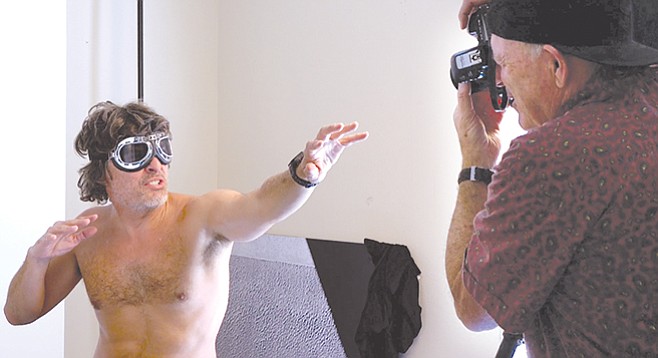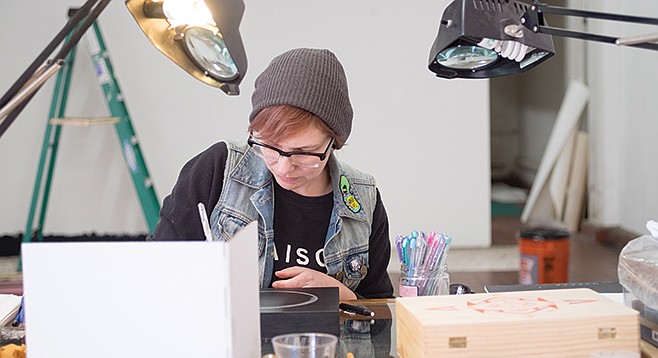 Facebook
Facebook
 X
X
 Instagram
Instagram
 TikTok
TikTok
 Youtube
Youtube

“Artist residences are about taking the time to explore your work in a new way,” says Melissa Walter, who is currently the artist-in-residence at Bread & Salt, “a gallery and experimental center for the arts.” From 11 a.m. to 4 p.m., Monday through Friday, passersby can pop in and watch as Walter, who is also an illustrator for NASA, experiments with “ways to make the invisible visible.” She will be creating an installation piece that explores that mysterious stuff of the universe known as dark matter. One aspect of dark matter, she explains, is the fact that we can’t see it.
“We know it exists by how it affects the things around it, and one of those things is light — if we’re looking into space, if there’s a galaxy and stars behind dark matter, then all of a sudden the light from those stars and galaxies will completely bend. It’s almost like looking through a water glass and light bends the image. And that bending of the light is called gravitational lensing.”

This is Walter’s first time as a resident artist. “Most of the people who come through are other artists or creatives somehow associated with events in the building,” she says. “Having creatives come through wound up being, surprisingly, one of my favorite parts about residency — everybody’s really open to sharing their process and resources. I’ve been working from home forever, and even when I was in college I didn’t take up the studio spaces that were offered to artists. It’s been quite wonderful getting to be more collaborative.”
During Walter’s first week, another artist, Michael James Armstrong, happened by her studio and, after some discussion, suggested new materials, including mylar. “It’s like transparency paper, really pliable and interesting — it hadn’t been on my radar before, but now I’m excited to try and incorporate it.”
Though most of the people in and out of the Bread & Salt artist-in-residence studio are other artists, the space is open to the public. “I don’t mind people watching me,” Walter says, “but I definitely think I’m unusual in that a lot of artists I know are more interested in being solitary.”
Fortunately for artists who’d rather not be watched as they work, there are more private residency programs, such as the one at the San Diego Art Institute. At the institute, artists receive a stipend ranging from $500 to $8000, depending on their project, and they work not at the Balboa Park location, but at the institute’s satellite location (141 Horton Plaza, Downtown), which is also where their finished pieces are exhibited to the public.
“I have actually found that artists hate [public] residencies,” says Ginger Shulick Porcella, executive director of the Art Institute. Porcella says that, typically, artists “just want to make work in private,” and that for artists who get accepted to the program, “The main benefit is being able to mount a solo exhibition, as well as the frequent visits with curators that we line up for artists-in-residence so that they get exposure in the larger art world outside of San Diego.”
The next exhibit, which opens March 31, will feature Noé Olivas, whose artwork “investigates the Mexican-American identity as a Californian” and “considers the relationship between labor/leisure as it fits into conceptions of femininity/masculinity, specifically by evaluating the myth of machismo and its relationship to patriarchal culture.”
Whereas San Diego Art Institute focuses solely on regional artists, Lux Art Institute is more interested in artists from abroad. Artists have been brought in from countries including Colombia, Cuba, India, and Poland. Because artists are not local, Lux’s residency program includes an actual residence: invited artists “recognized nationally and internationally” live and work onsite. The current artist-in-residence is Siro Cugusi, from Italy. Cugusi has been in-studio since January 21, and his work — a large oil abstract painting that “responds to his temporary surroundings” at Lux, along with smaller works and accompanying studies — will continue to exhibit through Saturday, March 18.
Lux Art Institute hosts artist talks and workshops that aim to engage teens and adults in the community. For kids, there are camps, classes, and family events. There is also a Kids-in-Residence program for children aged 5–8, in which students are guided to create a range of art projects inspired by whichever artist is in residence at the time ($160 for members, $200 for guests).
Most residencies are limited, rarely lasting longer than three months. But there are some organizations, such as The Artist Odyssey, that offer artists studio space for an indefinite amount of time. The Artist Odyssey is a global network of filmmakers who document artists and provide lessons for arts educators. Their hub in North County houses several studios as well as a gallery. Artists often collaborate with each other and cohost exhibition events. Two of the current artists-in-residence are art teacher and painter Angela Jackson and skateboard photographer J. Grant Brittain. Each studio has glass windows, so visitors can get a peek at what’s happening within. The artists come and go as they please, but if you want to check out their studios (and possibly catch them at work) visits can be scheduled by emailing [email protected].


“Artist residences are about taking the time to explore your work in a new way,” says Melissa Walter, who is currently the artist-in-residence at Bread & Salt, “a gallery and experimental center for the arts.” From 11 a.m. to 4 p.m., Monday through Friday, passersby can pop in and watch as Walter, who is also an illustrator for NASA, experiments with “ways to make the invisible visible.” She will be creating an installation piece that explores that mysterious stuff of the universe known as dark matter. One aspect of dark matter, she explains, is the fact that we can’t see it.
“We know it exists by how it affects the things around it, and one of those things is light — if we’re looking into space, if there’s a galaxy and stars behind dark matter, then all of a sudden the light from those stars and galaxies will completely bend. It’s almost like looking through a water glass and light bends the image. And that bending of the light is called gravitational lensing.”

This is Walter’s first time as a resident artist. “Most of the people who come through are other artists or creatives somehow associated with events in the building,” she says. “Having creatives come through wound up being, surprisingly, one of my favorite parts about residency — everybody’s really open to sharing their process and resources. I’ve been working from home forever, and even when I was in college I didn’t take up the studio spaces that were offered to artists. It’s been quite wonderful getting to be more collaborative.”
During Walter’s first week, another artist, Michael James Armstrong, happened by her studio and, after some discussion, suggested new materials, including mylar. “It’s like transparency paper, really pliable and interesting — it hadn’t been on my radar before, but now I’m excited to try and incorporate it.”
Though most of the people in and out of the Bread & Salt artist-in-residence studio are other artists, the space is open to the public. “I don’t mind people watching me,” Walter says, “but I definitely think I’m unusual in that a lot of artists I know are more interested in being solitary.”
Fortunately for artists who’d rather not be watched as they work, there are more private residency programs, such as the one at the San Diego Art Institute. At the institute, artists receive a stipend ranging from $500 to $8000, depending on their project, and they work not at the Balboa Park location, but at the institute’s satellite location (141 Horton Plaza, Downtown), which is also where their finished pieces are exhibited to the public.
“I have actually found that artists hate [public] residencies,” says Ginger Shulick Porcella, executive director of the Art Institute. Porcella says that, typically, artists “just want to make work in private,” and that for artists who get accepted to the program, “The main benefit is being able to mount a solo exhibition, as well as the frequent visits with curators that we line up for artists-in-residence so that they get exposure in the larger art world outside of San Diego.”
The next exhibit, which opens March 31, will feature Noé Olivas, whose artwork “investigates the Mexican-American identity as a Californian” and “considers the relationship between labor/leisure as it fits into conceptions of femininity/masculinity, specifically by evaluating the myth of machismo and its relationship to patriarchal culture.”
Whereas San Diego Art Institute focuses solely on regional artists, Lux Art Institute is more interested in artists from abroad. Artists have been brought in from countries including Colombia, Cuba, India, and Poland. Because artists are not local, Lux’s residency program includes an actual residence: invited artists “recognized nationally and internationally” live and work onsite. The current artist-in-residence is Siro Cugusi, from Italy. Cugusi has been in-studio since January 21, and his work — a large oil abstract painting that “responds to his temporary surroundings” at Lux, along with smaller works and accompanying studies — will continue to exhibit through Saturday, March 18.
Lux Art Institute hosts artist talks and workshops that aim to engage teens and adults in the community. For kids, there are camps, classes, and family events. There is also a Kids-in-Residence program for children aged 5–8, in which students are guided to create a range of art projects inspired by whichever artist is in residence at the time ($160 for members, $200 for guests).
Most residencies are limited, rarely lasting longer than three months. But there are some organizations, such as The Artist Odyssey, that offer artists studio space for an indefinite amount of time. The Artist Odyssey is a global network of filmmakers who document artists and provide lessons for arts educators. Their hub in North County houses several studios as well as a gallery. Artists often collaborate with each other and cohost exhibition events. Two of the current artists-in-residence are art teacher and painter Angela Jackson and skateboard photographer J. Grant Brittain. Each studio has glass windows, so visitors can get a peek at what’s happening within. The artists come and go as they please, but if you want to check out their studios (and possibly catch them at work) visits can be scheduled by emailing [email protected].
Comments